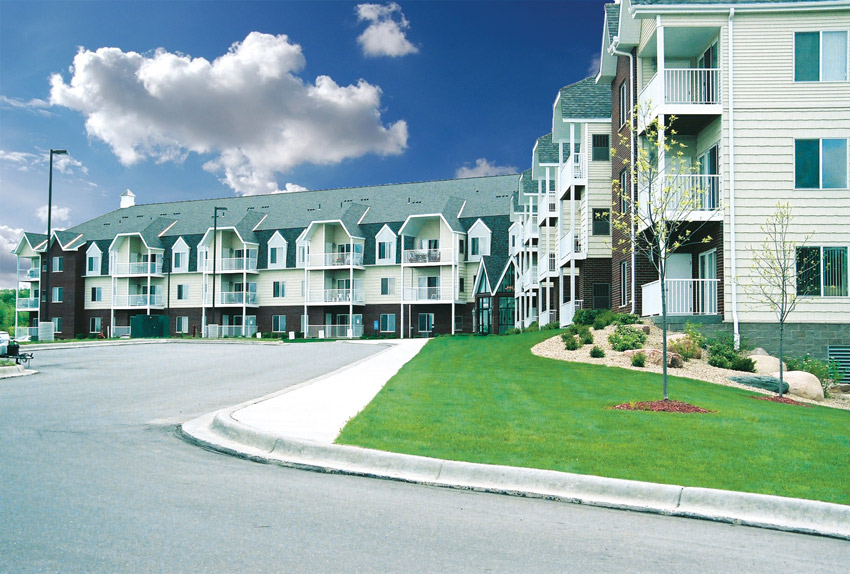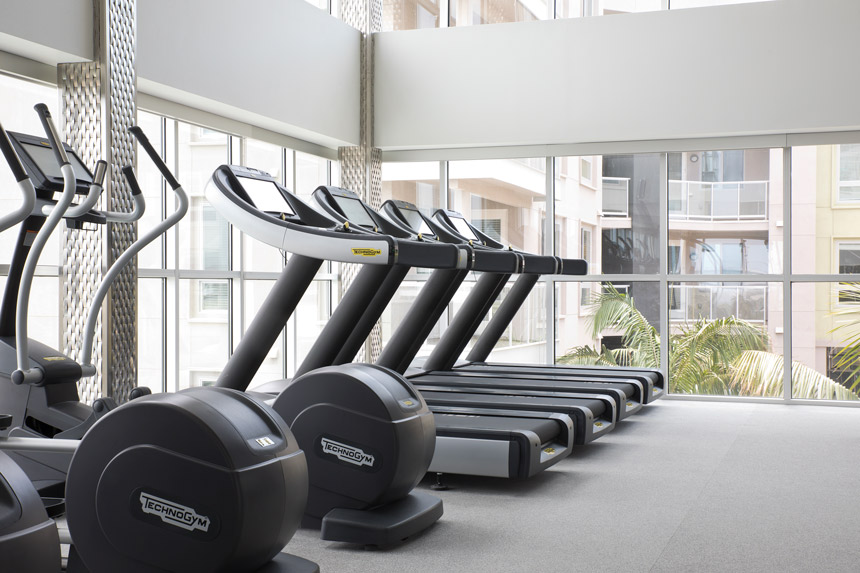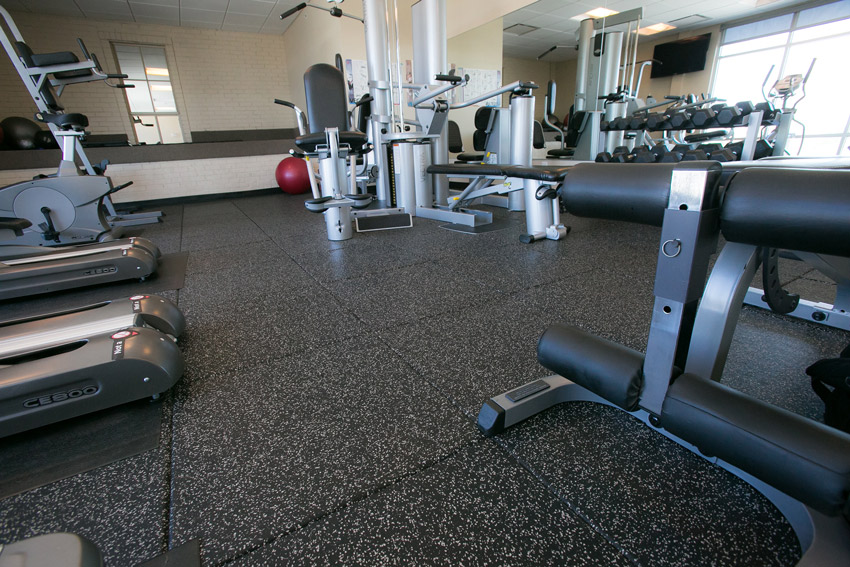Flooring Design with Acoustics in Mind
Multifamily
As mentioned earlier, most local building codes have strict minimums on acoustic ratings. Also, the Guide to Airborne, Impact, and Structure-Borne Noise Control in Multifamily Dwellings, published by U.S. Department of Housing and Urban Development, sets standards for controlling noise in multifamily dwellings.
But building code minimums are not sufficient for much of today’s construction, notably the new high-end urban complexes being built or renovated in large numbers all over the country to accommodate changing demographics. Flooring that helps absorb sound (high NRC rating) and reduce sound transmission (high IIC rating) is essential for peace, privacy, and sleep.
One strategy for controlling sound, particularly sound transmission, while still using a variety of surfaces is to use effective underlayments developed to provide sound control when installed in different configurations. In the Bard’s Crossing condominium development in Rosemount, Minnesota, (Figure 8) recycled rubber acoustic soundproofing mats were used as part of specially designed open-web floor/ceiling assemblies to control sound in a large, senior-targeted complex. The objective was to give the residents exceptional but cost-effective sound-reduction levels when installed under many different surfaces. According to Mike Vallez, project manager of design and construction for the developer Wensmann Homes, the choice of sound insulation “produced the highest IIC ratings of anything we’ve used. We were extremely satisfied with the results: IIC field ratings of 64 with wood, 55 with ceramic tile, and 56 with vinyl.”
Figure 8

“When people are buying condos, they don’t want to hear the neighbors walking all over the place, so acoustics are important,” says Mike Vallez, project manager of design and construction for Wensmann Homes, the developers of many projects including Bard’s Crossing, a retirement community condominium in a suburb of St. Paul, Minnesota. The flooring solution included 83,000 square feet of a rubber sound-control underlayment that provided better noise deadening than other sound-insulation products used in previous projects.
Fitness and Hospitality
Fitness and hospitality buildings are included together here for two reasons. First, because sound transmission (measured particularly by IIC and ∆IIC ratings) is a key issue in both types. And second, because the two functions are more and more often found in close physical proximity. Impressive, well-equipped fitness spaces are an essential component of most hotels, as well as most full-service urban residential and multipurpose buildings. Sound transmission between rooms and floors is a constant issue. In hotels (as well as restaurants and dedicated fitness clubs) operating in our world of instant viral reviews, noise in the wrong place at the wrong time can have lasting impact on the bottom line. In many urban buildings, there are bars, restaurants, living spaces, and fitness areas close together.
For the users of fitness spaces, flooring can improve safety and performance while isolating sound between one space, say the tango aerobics class, and another, possibly a restorative yoga class.
For neighbors of fitness spaces, they are better isolated from loud noises such as pounding feet and dropped weights.
Vive on the Park (Figure 9), an upscale apartment complex in San Diego has a slogan that could apply to new and renovated buildings going up in many urban neighborhoods: “Luxe living in the middle of it all.” The state-of-the-art, multilevel fitness center is located on an upper level of the multistory apartment complex. Since there are residential units below the gym, acoustic surfacing was required to control sound. The products that were chosen featured recycled rubber backing with a number of different surfaces coordinated with the sleek, contemporary styling of the rest of the building.
Figure 9

Vive on the Park is a multistory apartment complex in San Diego where the fitness center is located above residences. Designers specified engineered vinyl, turf, and rubber surfaces with a performance rubber backing in order to control sound.
NuStyle Development Corporation (NDC) had a similar design challenge, and it took more than one try to find just the right solution. NDC is credited with helping to transform downtown Omaha, and among many remarkable buildings restored by the company is The Slate on N. 19th St. After a period of product testing, recycled rubber underlayment was installed in the building’s fitness areas (Figure 10), with the specific objective of reducing sound transmission between floors to the apartments below.
The first approach, using a 5-millimeter recycled rubber sound-control underlayment, made a significant positive difference—but some sound was still being transmitted to the apartments downstairs. “While the decibel drop between the weight area and the floor below performed above apartment standards (achieving FIIC 67 where code requirements are FIIC 45), we still needed something a bit more insulating for the weight rooms,” says Greg Rothermel, development director for NDC. NuStyle Developers again approached the technicians at the same manufacturer, asking for further suggestions to eliminate sound transmission caused by the treadmills and free weights.
Additional tests were performed, including standard IIC tapping machines tests, treadmill tests, and 50-pound dumbbell drop tests. Based on the results, the company recommended a 2.5-inch rubber tile to be installed on top of the existing sound-control underlayment. The developer was so pleased with the results that variations of the system have since been installed in two other NDC properties, so the residents are peacefully free of treadmill and weight drop noise too.
Figure 10

The Slate in Omaha, Nebraska, features a fitness center surrounded by apartments. The developers specified a 2.5-inch rubber tile with a 5-millimeter rubber underlayment to prevent weight room noise from traveling to rooms below it.
Out With The Carpet, In With …
Issues related to acoustic performance in all types of buildings, both commercial and residential, are getting more attention lately because of significant shifts in flooring trends away from carpet in favor of tile, marble, granite, and hardwood. Carpet has always been the go-to material to muffle sound. In fact, in some condo associations and apartment complexes, there are long-standing rules requiring a certain amount of carpet to prevent noise in adjacent spaces.
As we’ve seen, carpet is becoming steadily less desirable in today’s interiors. It is difficult to clean and almost impossible to disinfect, so it cannot be used at all in many health-care and education settings, where it has the added disadvantage of making equipment more difficult to maneuver. Carpet can also look dirty even when it’s well maintained.
But carpet has always had one advantage: acoustics. Carpet absorbs sound and vibration to a high degree. Carpet might fall short of today’s modern, streamlined aesthetic, but beautiful hard-surfaced flooring can create real noise problems.
Owners who want to take out carpet and replace it with hard flooring can get a big (and not pleasant) surprise in how noisy they are. Hard flooring might look and clean better, but that may not matter to occupants struggling to hear each other or neighbors dealing with increased noise.
Beyond acoustic considerations, replacing carpet means paying attention to important safety factors. Those hard materials so desirable in today’s interiors such as stone, tile, and hardwood are inherently less forgiving than carpet, which in sufficient thickness could offer a measure of protection against injuries from falls.
So a focus of research into flooring surface and underlayment technologies has been to combine increased acoustic benefits with the other positive performance attributes of resilient flooring. For example, a study by The Acoustics Laboratory at the University of Hartford in Hartford, Connecticut, examined the acoustic performance of common flooring products in health-care settings. The levels of sound from common sources of hospital noise, such as footfalls, corridor noise, and rolling carts, were measured under controlled conditions simulating rooms with common carpet, vinyl, and rubber flooring surfaces. The study aimed to establish ways to measure surface-generated sound in order to quantify how much a flooring material contributes to the actual quietness of a room, beyond the usual NRC measure of how much sound a material absorbs. The results of the testing indicated that a no-wax vinyl surface fusion-bonded to a 90 percent post-consumer recycled rubber backing provided the same level of quiet as carpet.
This type of engineered surfacing—a resilient floor bonded to a recycled rubber underlayment—was used in the Paseo Verde Library in Henderson, Nevada, to replace its 12-year-old shredded and discolored carpet. The library wanted to create a more inviting, contemporary atmosphere but also required durability and acoustic performance to stand up to the noise and traffic generated by the library’s adjacent cafe. “We wanted something that was easier to clean and would last longer than carpet, and we were willing to sacrifice a bit of noise to have the new floor,” says Library Manager Joan Dalasung. “But it’s just as quiet as carpet; we have been very happily surprised about that. It’s not just people walking across it; we are constantly rolling book carts and small furniture over it, and it has not only held up wonderfully, but the space has also remained quiet. It has surpassed our expectations on an acoustic level.”









